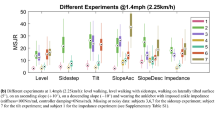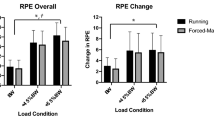Abstract
The uncontrolled manifold (UCM) approach allows us to address issues concerning the nature of variability. In this study we applied the UCM analysis to gait and to a population known for exhibiting high levels of performance variability, Down syndrome (DS). We wanted to determine if preadolescents (ages between 8 and 10) with DS partition goal-equivalent variability (UCM‖) and non-goal equivalent variability differently than peers with typical development (TD) and whether treadmill practice would result in utilizing greater amounts of functional, task-specific variability to accomplish the task goal. We also wanted to determine how variance is structured with respect to two important performance variables: center of mass (COM) and head trajectory at one specific event (i.e., heel contact) for both groups during gait. Preadolescents with and without DS walked on a treadmill below, at, and above their preferred overground speed. We tested both groups before and after four visits of treadmill practice. We found that children with DS partition more UCM‖ variance than children with TD across all speeds and both pre and post practice. The results also suggest that more segmental configuration variance was structured such that less motion of COM than head position was exhibited at heel contact. Overall, we believe children with DS are employing a different control strategy to compensate for their inherent limitations by exploiting that variability that corresponds to successfully performing the task.








Similar content being viewed by others
References
Assaiante C, Amblard B (1992) Peripheral vision and age-related differences in dynamic balance. Hum Mov Sci 11:533–548
Assaiante C, Amblard B (1993) Ontogenesis of head stabilization in space during locomotion in children: influence of visual cues. Exp Brain Res 93:499–515
Bauby CE, Kuo AD (2000) Active control of lateral balance in human walking. J Biomech 33:1433–1440
Bernstein NA (1967) The coordination and regulation of movements. Pergamon, New York
Berthoz A, Pozzo T (1988) Intermittent head stabilization during postural and locomotory tasks in humans. In: Arnblard B, Berthoz A, Clarac F (eds) Posture and gait: development, adaptation and modulation. Elsevier, Amsterdam, pp 189–198
Block ME (1991) Motor development in children with Down syndrome: a review of the literature. Adapted Physical Activity Quarterly 8:179–209
Buzzi U, Ulrich B (2004) Dynamic stability of gait cycles as a function of speed and system constraints. Motor Control 8(3):241–254
Coburn J, Crisco J (2005) Interpolating three-dimensional kinematic data using Quaternion Splines and Hermite curves. J Biomech Eng 127:311–317
Chapman RS, Hesketh LJ (2000) Behavioral phenotype of individuals with Down syndrome. Ment Retard Dev Disabil Res Rev 6:84–95
Cronk CE, Chumlea WC, Roche AF (1985) Assessment of overweight children with trisomy 21. Am J Ment Defic 89(4):433–436
Davis WE, Kelso JAS (1982) Analysis of “invariant characteristics” in the motor control of Down’s syndrome and normal subjects. J Mot Behav 14(3):194–212
Diamond LS, Lynne D, Sigman B (1981) Orthopedic disorders in patients with Down’s syndrome. Orthop Clin North Am 12(1):57–71
Domkin D, Laczki J, Jaric S, Johansson H, Latash ML (2002) Structure of joint variability in bimanual pointing tasks. Exp Brain Res 143:11–23
Dyer S, Gunn P, Rauh H, Berry P (1990) Motor development in Down syndrome children: an analysis of the motor scale of the Bailey scales of infant development. Med Sports Sci 30:7–20
Elliot D, Weeks DJ (1990) Cerebral specialization and the control of oral and limb movements for individuals with Down's syndrome. J Mot Behav 22:6–18
Frith U, Frith CD (1974) Specific motor disabilities in Down’s syndrome. J Child Psychol Psychiatr 15(4):293–301
Gelfand IM, Tsetlin ML (1966) On mathematical modeling of the mechanisms of the central nervous system. In: Gelfand IM, Gurfinkel VS, Fomin SV, Tsetlin ML (eds) Models of the structural-functional organization of certain biological systems. Nauka, Moscow, pp 9–26
Haken H, Kelso JAS, Bunz H (1985) A theoretical model of phase transitions in human hand movements. Biol Cybern 51:347–356
Henderson SE, Morris J, Frith U (1981) The motor deficit in Down’s syndrome: a problem with timing? J Child Psychol Psychiatr 22(3):233–245
Holt K, Ratcliffe R, Jeng S-F (1999) Head stability in walking in Children with cerebral palsy and in children and adults without neurological Impairment. Phys Ther 79:1153–1162
Hreljac A, Marshall RN (2000) Algorithms to determine event timing during normal walking using kinematic data. J Biomech 33:783–786
Jeng S-F, Holt KG, Fetters L, Certo C (1996) Self-optimization of walking in nondisabled children and children with spastic hemiplegic cerebral palsy. J Mot Behav 28:15–27
Krishnamoorthy V, Yang J-F, Scholz JP (2005) Joint coordination during quiet stance: effects of vision. Exp Brain Res 164:1–17
Kubo M, Ulrich BD (2006) Early stages of walking: development of control in mediolateral and anterorposterior directions. J Mot Behav 38:229–237
Latash ML, Anson JG (1996) What are “normal movements” in atypical populations? Behav Brain Sci 19(1):55–106
Latash ML, Danion F, Scholz JF, Zatsiorsky VM, Schoner G (2003) Approaches to analysis of handwriting as a task of coordination a redundant motor system. Hum Mov Sci 22:153–171
Latash ML, Scholz JP, Danion F, Schöner G (2001) Structure of motor variability in marginally redundant multifinger force production tasks. Exp Brain Res 141:153–165
Latash ML, Scholz JP, Schöner G (2002) Motor control strategies revealed in the structure of motor variability. Exerc Sport Sci Rev 30:26–31
Looper J, Wu J, Angulo Barroso R, Ulrich D, Ulrich BD (2006) Changes in step variability of new walkers with typical development and with Down syndrome. J Mot Behav 38(5):367–372
Pozzo T, Berthoz A, Lefort L (1990) Head stabilization during various locomotor tasks in humans: normal subjects. Exp Brain Res 82:97–106
Riccio GE (1993) Information in movement variability about the qualitative dynamics of posture and orientation. In: Newell KM, Corcos D (eds) Variability and motor control, Human Kinetics, Champaign, pp 317–357
Riley MA, Turvey MT (2002) Variability and determinism in motor behavior. J Mot Behav 34(2):99–125
Scholz JP, Schöner G (1999) The uncontrolled manifold concept: Identifying control variables for a functional task. Exp Brain Res 126:289–306
Scholz JP, Schöner G, Latash ML (2000) Identifying the control structure of multijoint coordination during pistol shooting. Exp Brain Res 135:382–404
Scholz JP, Kang N, Patterson D, Latash M (2003) Uncontrolled manifold analysis of single trials during multi-finger force production by persons with and without Down syndrome. Exp Brain Res 153:45–58
Shumway-Cook A, Woollacott MH (1985) The growth of stability: postural control from a development perspective. J Mot Behav 17:131–147
Slifkin AB, Newell KM (1999) Noise, information transmission, and force variability. J Exp Psychol Hum Percept Perform 25:837–851
Smith BA, Kubo M, Black DP, Holt KG, Ulrich, B (2007). Impact of practice on a novel task, walking on a treadmill: preadolescents with and without Down syndrome. Phys Ther (submitted)
Thelen E, Corbetta D, Kamm K, Spencer JP, Schneider K, Zernicke RF (1993) The transition to reaching: mapping intention and intrinsic dynamics. Child Dev 64:1058–1098
Thelen E, Ulrich B (1991) Hidden skills: a dynamic analysis of treadmill stepping during the first year. Monogr Soc Res Child Dev 56 (1, Serial No. 23)
Ulrich B, Haehl V, Buzzi UH, Kubo M, Holt KG (2004) Modeling dynamic resource utilization in population with unique constraints: preadolescents with and without Down syndrome. Hum Mov Sci 23:133–156
van Emmerik RE, van Wegen EE (2000) On variability and stability in human movement. J Appl Biomech 16:394–406
Weeks DJ, Chua R, Elliott D (2000) Perceptual-motor behavior in Down syndrome. Human Kinetics, Champagne
Winter DA (1990) Biomechanics and motor control of human movement. Wiley, New York
Woodhouse JM, Meades JS, Leat SJ, Sauders KJ (1993) Reduced accommodations in children with Down syndrome. Invest Ophthalmol Vis Sci 34:2382–2387
Acknowledgments
We thank Masayoshi Kubo for programming assistance. We also wish to thank the children and families that participated in this study, particularly from the Michigan and northern Ohio parent-support groups. This research was supported by the National Institutes of Health (NIH) via a grant awarded to Beverly Ulrich (R01-HD42728–01).
Author information
Authors and Affiliations
Corresponding author
Rights and permissions
About this article
Cite this article
Black, D.P., Smith, B.A., Wu, J. et al. Uncontrolled manifold analysis of segmental angle variability during walking: preadolescents with and without Down syndrome. Exp Brain Res 183, 511–521 (2007). https://doi.org/10.1007/s00221-007-1066-1
Received:
Accepted:
Published:
Issue Date:
DOI: https://doi.org/10.1007/s00221-007-1066-1




